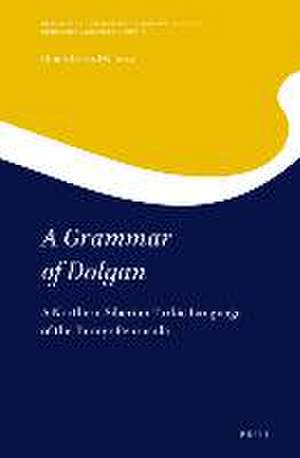A Grammar of Dolgan: A Northern Siberian Turkic Language of the Taimyr Peninsula: Grammars and Sketches of the World's Languages / Indigenous Languages of Russia, cartea 18
Autor Chris Lasse Däbritzen Limba Engleză Hardback – 31 aug 2022
Preț: 902.12 lei
Preț vechi: 1100.14 lei
-18% Nou
Puncte Express: 1353
Preț estimativ în valută:
172.64€ • 179.58$ • 142.53£
172.64€ • 179.58$ • 142.53£
Carte indisponibilă temporar
Doresc să fiu notificat când acest titlu va fi disponibil:
Se trimite...
Preluare comenzi: 021 569.72.76
Specificații
ISBN-13: 9789004516236
ISBN-10: 9004516239
Dimensiuni: 155 x 235 mm
Greutate: 0 kg
Editura: Brill
Colecția Brill
Seria Grammars and Sketches of the World's Languages / Indigenous Languages of Russia
ISBN-10: 9004516239
Dimensiuni: 155 x 235 mm
Greutate: 0 kg
Editura: Brill
Colecția Brill
Seria Grammars and Sketches of the World's Languages / Indigenous Languages of Russia
Notă biografică
Chris Lasse Däbritz completed his Ph.D. in General Linguistics in 2020 and works as a research fellow at the University of Hamburg. His most important publications include the INEL Dolgan Corpus and a monograph on information structure in North-Western Siberian languages.
Cuprins
Preface
Abbreviations
List of Charts, Figures and Maps
1 Introduction
1.1How to Read This Book
1.2The Speakers of Dolgan
1.3Historical and Ethnographical Background
1.4Traditional Way of Life
1.5The Language
1.6Material and Data
2 Phonology and Phonetics
2.1Vowel System
2.2Consonant System
2.3Phonotactics
2.4Prosody
2.5Morphonological Processes
3 Word Classes
3.1Nouns
3.2Adjectives
3.3Pronouns
3.4Numerals and Quantifiers
3.5Verbs
3.6Adverbs
3.7Postpositions
3.8Particles and Clitics
3.9Interjections, Conversational Formulas and Onomatopoeia
4 Nominal Inflectional Morphology
4.1Number
4.2Case
4.3Possession
4.4Predicate Forms of Nominals
5 Pronominal Inflectional Morphology
5.1Personal Pronouns
5.2Other Pro-Forms
6 Verbal Inflectional Morphology
6.1Verbal Stems
6.2Sets of Personal Endings
6.3Non-finite Verb Forms
6.4Tense-Aspect Forms
6.5Mood, Modality and Illocution
6.6Evidentiality
7 Non-clausal Syntax
7.1Noun Phrase
7.2Adjective Phrase
7.3Verb Phrase
7.4Adpositional Phrase
7.5Adverb Phrase
8 Clausal Syntax—Simple Clauses
8.1Verbal Predication
8.2Non-verbal Predication
8.3Syntax of Adverbials
8.4Non-declarative Clauses
8.5Negation in Simple Clauses
9 Clausal Syntax—Complex Clauses
9.1Clause Chaining
9.2Coordination
9.3Subordination
10 Discourse Organization
10.1Word Order
10.2Information Structure
10.3Reference Tracking and Information Status
10.4False Starts, Fillers and Placeholder Items
10.5Direct and Indirect Speech
11 Lexicon
11.1Semantic Fields
11.2Loanwords
12 Derivational Processes
12.1Nominal > Nominal
12.2Verb > Nominal
12.3Nominal > Verb
12.4Verb > Verb
13 Sample Texts
13.1Text 1: The Reindeer and the Mouse
13.2Text 2: Dolgan Birth Customs
13.3Text 3: Discussing the Correct Order
13.4Text 4: We Hit the Road Again
13.5Text 5: Khatanga’s School—90 Years
14 References
Index
Abbreviations
List of Charts, Figures and Maps
1 Introduction
1.1How to Read This Book
1.2The Speakers of Dolgan
1.3Historical and Ethnographical Background
1.4Traditional Way of Life
1.5The Language
1.6Material and Data
2 Phonology and Phonetics
2.1Vowel System
2.2Consonant System
2.3Phonotactics
2.4Prosody
2.5Morphonological Processes
3 Word Classes
3.1Nouns
3.2Adjectives
3.3Pronouns
3.4Numerals and Quantifiers
3.5Verbs
3.6Adverbs
3.7Postpositions
3.8Particles and Clitics
3.9Interjections, Conversational Formulas and Onomatopoeia
4 Nominal Inflectional Morphology
4.1Number
4.2Case
4.3Possession
4.4Predicate Forms of Nominals
5 Pronominal Inflectional Morphology
5.1Personal Pronouns
5.2Other Pro-Forms
6 Verbal Inflectional Morphology
6.1Verbal Stems
6.2Sets of Personal Endings
6.3Non-finite Verb Forms
6.4Tense-Aspect Forms
6.5Mood, Modality and Illocution
6.6Evidentiality
7 Non-clausal Syntax
7.1Noun Phrase
7.2Adjective Phrase
7.3Verb Phrase
7.4Adpositional Phrase
7.5Adverb Phrase
8 Clausal Syntax—Simple Clauses
8.1Verbal Predication
8.2Non-verbal Predication
8.3Syntax of Adverbials
8.4Non-declarative Clauses
8.5Negation in Simple Clauses
9 Clausal Syntax—Complex Clauses
9.1Clause Chaining
9.2Coordination
9.3Subordination
10 Discourse Organization
10.1Word Order
10.2Information Structure
10.3Reference Tracking and Information Status
10.4False Starts, Fillers and Placeholder Items
10.5Direct and Indirect Speech
11 Lexicon
11.1Semantic Fields
11.2Loanwords
12 Derivational Processes
12.1Nominal > Nominal
12.2Verb > Nominal
12.3Nominal > Verb
12.4Verb > Verb
13 Sample Texts
13.1Text 1: The Reindeer and the Mouse
13.2Text 2: Dolgan Birth Customs
13.3Text 3: Discussing the Correct Order
13.4Text 4: We Hit the Road Again
13.5Text 5: Khatanga’s School—90 Years
14 References
Index

